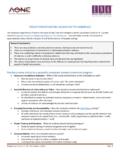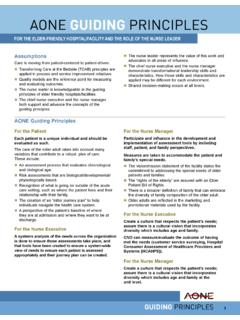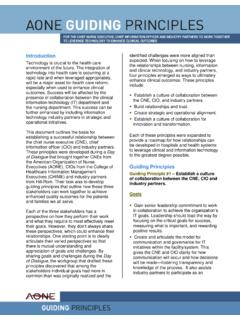Transcription of Care Innovation and Transformation - AONE
1 Care Innovation and TransformationTo Shape Health Care Through Innovative and Expert Nursing Leadership3 Table of ContentsCIT faculty and keynote speakers 4 Traditional CITTM vs. Customized CITTM Program 5 CIT program helps nurse units improve outcomes in patient experience and employee engagement 6 Cindy Brown, MSN, MHA, RN, CAAMA-FACCA, BC, vice president, HealthPark Medical Center & Heart and Vascular Institute, Fort Myers, Fla. CIT empowers nurses to lead change for improved patient care 8 Bob Dent, DNP, MBA, RN, NEA-BC, CENP, FACHE, senior vice president and chief operating officer , Midland Memorial Hospital, Midland, TexasCIT drives staff-led Innovation that improves the quality of care 10 Adele Keeley, MA, RN, nurse director of Phillips 21, Massachusetts General Hospital, Boston, empowers staff to bring innovations to life 12 Danette Butterfield, MSN, RN, nurse director, Neurological Telemetry (NT)/Neurological Progressive Care Unit (NPCU), Methodist Hospital, San Antonio, TexasCIT fosters ownership and accountability of nursing practice 14 Marites Garcia, BSN, RN, CMSRN, charge nurse, quality council chair & CIT co-lead, Gulf Coast Medical Center, General Medicine, Fort Myers, from the DirectorThe CIT program improves outcomesWe all want to achieve better outcomes.
2 The challenge is discovering how. How do I identify opportunities for change? How should I empower my staff? How do I encourage bottom-up, not top-down, problem solving? How do I lead differently? How, exactly, can we achieve better outcomes?The American Organization of Nurse Executives (AONE) Care Innovation and Transformation (CIT) program answers these questions and more, all within a framework of guiding participating organizations in their redesign of care delivery. CIT provides nurse leaders with the knowledge and tools to improve patient care, hospital performance and employee satisfaction through the engagement of frontline staff, collaboration, Innovation and leadership development. The program teaches nursing and interdisciplinary teams how to innovate and measure change, strengthening the organization from the bottom director of CIT, I have had the privilege of collaborating with many frontrunners of Innovation in the nursing community, and witnessing stories of dramatic change and outcome improvement.
3 I invite you to consider the benefits of CIT participation in our next cohort, and envision the change you and your team can first, continue reading about your nurse leader colleagues as they offer first-hand accounts of how the CIT program inspired their teams to embrace change and adopt innovative practices that improved clinical outcomes and the overall quality of ,Amanda Stefancyk Oberlies, MSN, MBA, RN, CENP, PhD(c) Director, Center for Care Innovation and Transformation AONECIT faculty and keynote speakersDebra Gerardi, JD, MPH, RNDebra Gerardi, JD, MPH, RN, is chief creative officer , Emerging Healthcare Communities (EHCCO), Half Moon Bay, Calif. Debra is a mediator and health care conflict engagement specialist providing mediation and facilitation services, conflict assessment and coaching, systems design and conflict engagement training programs for healthcare organizations internationally. She has provided professional services to over 100 leading organizations including: the American Association of Critical-Care Nurses, the Agency for Healthcare Research and Quality, the Joint Commission and Joint Commission Resources, the World Health Organization World Alliance for Patient Safety, and more.
4 Rosemary Gibson, MScRosemary Gibson, MSc, is senior advisor to The Hastings Center and an editor for JAMA Internal Medicine. She led national initiatives to improve health care quality and safety at the Robert Wood Johnson Foundation for 16 years. She was chief architect of the foundation s decade-long strategy that successfully established palliative care in more than 1,600 hospitals in the She is the recipient of the Lifetime Achievement Award from the American Academy of Hospice and Palliative Medicine. Barbara Mackoff, EdDBarbara L. Mackoff, EdD, is a consulting psychologist, author, and educator and a recognized authority on nursing management and leadership. She is an AONE senior faculty member and a Fulbright specialist. She has been a visiting professor at Adelphi University as well as at the Molloy College School of Nursing s PhD Program, a visiting scholar at Massachusetts General Hospital and Brigham and Women s Hospital in Boston. She is the author of six books, including Nurse Manager Engagement: Strategies for Excellence and Commitment.
5 Rocco Perla, EdDRocco J. Perla, EdD, director, analytics, UMass Memorial Health Care (UMMHC), oversees the measurement program in the Office of Quality and Patient Safety and provides leadership in the areas of improvement science, statistical process control, survey design, and dashboard development. He is also assistant professor of Family Medicine and Community Health at the UMass Medical School where he works in the area of program evaluation and outcome assessment. Dr. Perla is a consultant to academia, industry, and government and was a 2008-2009 George W. Merck Fellow at the Institute for Healthcare Improvement. Timothy Porter O Grady, DM, EdD, ScD(h), APRN, FAAN, FACCWSTim Porter-O Grady, DM, EdD, ScD(h), APRN, FAAN, FACCWS, is the senior partner of Tim Porter-O Grady Associates, Inc., in Atlanta, Ga. He is associate professor, leadership scholar, Arizona State University, College of Nursing and Health Innovation , Phoenix, Ariz.; clinical professor and leadership scholar at the Ohio State University College of Nursing in the Executive DNP program; a member of the Dean s Advisory Board and an adjunct professor at Emory University, School Nursing, Atlanta, Ga.
6 4 Gina Adair (left), nurse manager, and her team from Texas Health Harris Methodist Hospital Southwest Fort Worth, Texas, presenting their poster at a recent CIT meeting in New Orleans. Traditional CIT vs. Customized CIT programWhat is CIT?AONE believes the care models of the future will be significantly different than those used today. The Center for Care Innovation and Transformation is the laboratory where leaders develop the skill sets needed to design new care models. The Care Innovation and Transformation (CIT) program is a collaborative, workshop-style of series of lectures and training modules conducted by AONE designed to help nursing unit leaders and their staff improve patient care, hospital performance, and employee engagement. While CIT emphasizes change through nursing leadership, its approach is not exclusive. The CIT program teaches an interdisciplinary approach to quality improvement, offering the bedside nurse the opportunity to offers two types of programs: the Traditional CITTM program and the Customized CITTM CIT programThe Traditional CIT program brings inpatient units as well as pre- and post-acute care settings (ambulatory, rehabilitation, long-term care, among others) together as a learning cohort providing nursing and interdisciplinary team instruction in Innovation and change.
7 Each CIT cohort is comprised of 15-20 hospitals or health care organization teams from across the nation that progress together as a learning community during the two year program. Instruction is offered to CIT program participants at two meetings per year in venues across the country. Additionally, program participants engage in monthly conference calls and webinars to share progress CIT programThe Customized CIT program provides the same training and education benefits as the traditional program and takes place on your organization s campus to reach more units, more efficiently, and with less expenditure. Up to 20 inpatient units, departments, and pre-and post-acute care settings may participate per program. The program is designed to meet your organization s specific needs, with a focus on achieving your goals and priorities. The customized program provides the opportunity to train more participants in less time than the Traditional CIT program and because CIT comes to your campus, you save the costs associated with travel for your program participants.
8 While this approach limits the interaction with unit teams across the country, you are encouraged to include your organization s pre-and post-acute care colleagues to diversify innovations, enhance relationships, and improve care across the Ruddy (second from left) and her team from Main Line Health Paoli Hospital, Paoli, Pa., presenting their poster at a recent CIT meeting in Charleston, 6 Cindy Brown, MSN, MHA, RN, CAAMA-FACCA, BC, vice president, HealthPark Medical Center & Heart and Vascular Institute, Fort Myers, Fla., spoke with AONE about how the Care Innovation and Transformation (CIT) program transformed the staff culture and improved patient satisfaction and employee engagement a nurse leader, what interested you about the CIT program and led to your hospital submitting an application to participate in CIT?The decision to have our nurses participate in the Care Innovation and Transformation (CIT) program came from Donna M. Giannuzzi, our chief patient care officer and chief administrative officer for HealthPark Medical Center, part of Lee Memorial Health had prior experience with the Transforming Care at the Bedside (TCAB) program and knew our health system would benefit from the CIT program.
9 Each one of our four acute care facilities chose one unit to participate in the CIT CIT journey at HealthPark Medical Center began two years ago at a cohort meeting in Orlando, Fla. We selected the medical/surgical units because we believed they had the greatest opportunity for improvement, and the nursing directors were committed to process improvement and a shared governance model of management. As vice president for HealthPark, I ve always believed our staff nurses at the forefront of care delivery have the answers and that leaders have the opportunity to empower nurses to adopt best practices that improve care and create a more efficient workplace. I knew the CIT program would provide the training and resources to support our nurses and nursing directors to do just outcomes were experienced as a result of the program?We have seen a change in the culture of the CIT teams. There is a big difference when you walk on the units, you can see the teamwork, you can feel the spirit, the engagement, and the focus on patient safety.
10 It s a palpable cultural difference. The nurses have each other s backs, they are concerned about what is best for the patient, making sure the patient is safe and well cared for. Because the culture change was so palpable on the unit, I was confident our data would show an improvement and it did. For example, our 7 West CIT team posted impressive improvements to their unit s Patient Experience Value-Based Dimensions. The eight dimensions include: RN communication, MD communication, responsiveness of staff, pain management, communication about medications, cleanliness and quietness, discharge information, and overall rating. At baseline, in March of 2013, the team s average in these Value-Based Dimensions was 59%. Fast forward to the next year, that number rose to 83% and 76% in March and September, respectively Cindy Brown (right) and her team of nurse leaders at the CIT meeting in New program helps nurse units improve outcomes in patient experience and employee engagement7(see Graph 1).












